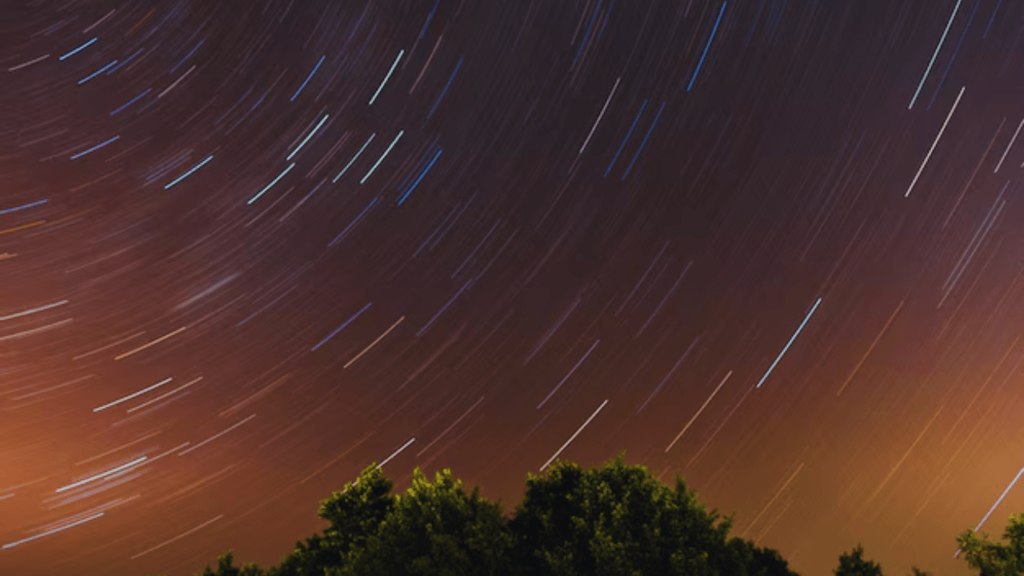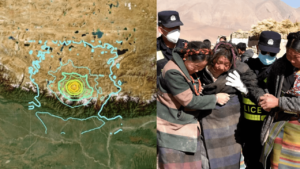NASA has issued a call for Americans to escape urban light pollution this weekend to witness the peak of the Perseid meteor shower. This annual event promises a dazzling display of up to 75 meteors per hour.

Every year, as the Earth traverses its orbit around the sun, it encounters a spectacular cosmic event that captivates skygazers across the globe—the Perseid meteor shower. Known for its high frequency of shooting stars, this meteor shower is a must-see event for astronomy enthusiasts and casual observers alike. As the Perseids peak this weekend, NASA has issued a special alert, urging Americans to leave the bright lights of the city behind and venture into darker areas to fully appreciate the show.
What Makes the Perseid Meteor Shower So Special?
The Perseid meteor shower is often hailed as the most impressive meteor display of the year, with NASA even dubbing it the ‘fireball champion’ due to the unusually bright meteors that frequently occur during this event. Originating from the debris left behind by the Swift-Tuttle comet, these meteors are the remnants of the comet’s passages through the inner solar system. As Earth passes through this debris, particles enter our atmosphere at astonishing speeds of up to 26.5 miles per second, burning up and creating the streaks of light we see as shooting stars.
This year’s meteor shower began on July 14 and will continue through September 1, with the peak occurring between Sunday night and early Monday morning. During this peak, viewers can expect to see between 50 and 75 meteors per hour, making for an unforgettable celestial display.
Why Urban Areas Are Not Ideal for Viewing?
While the Perseid meteor shower is visible from many parts of the world, NASA has advised that urban areas may not offer the best viewing experience. The primary reason for this is light pollution—a phenomenon where artificial lighting from cities brightens the night sky, making it difficult to see faint stars and meteors. This light pollution significantly diminishes the visibility of the Perseids, especially the fainter meteors that make up a large portion of the shower.
To truly enjoy the Perseid meteor shower in all its glory, NASA recommends finding a location far from the city lights. The darker the sky, the more meteors you will be able to see streaking across the heavens.
Ideal Time to Witness the Perseid Meteor Shower
Timing is crucial when it comes to viewing the Perseid meteor shower. According to NASA, the best time to observe the meteors is between 12 a.m. and 5:30 a.m. during the peak period. This is when the sky is darkest, as the moon will have set, providing a perfect backdrop for the meteors. The pre-dawn hours are particularly ideal because the constellation Perseus, from which the meteors appear to radiate, will be well above the horizon, increasing the likelihood of spotting numerous meteors.

How to Locate the Perseus Constellation?
To maximize your viewing experience, it’s important to know where to look in the sky. The Perseid meteors appear to originate from the Perseus constellation, located in the northern sky. Perseus is the 24th largest constellation and can be found rising in the northeast after dark. While you can see meteors anywhere in the sky, keeping an eye on the northeastern region will increase your chances of spotting the brightest ones.
For those unfamiliar with stargazing, there are several tools and apps available that can help you locate the Perseus constellation. Additionally, many Dark Sky Parks across the country offer ideal viewing conditions with minimal light pollution, making them excellent spots to witness the meteor shower.
Preparing for the Viewing Experience
To ensure you have the best possible experience, it’s important to come prepared. Here are some tips to help you get the most out of your Perseid meteor shower viewing:
- Choose a Dark Location: As mentioned earlier, the darker the location, the better your chances of seeing more meteors. Look for a spot far from city lights with an unobstructed view of the sky.
- Check the Weather: Before heading out, check the local weather forecast to ensure that clouds or rain won’t obstruct your view. Clear skies are essential for a successful meteor-watching experience.
- Dress Comfortably: The pre-dawn hours can be chilly, so dress warmly and bring blankets or chairs for comfort. Bug spray is also recommended to keep insects at bay.
- Avoid Light Distractions: To maintain your night vision, avoid looking at your phone or other sources of white light. It can take up to 30 minutes for your eyes to fully adjust to the darkness.
- No Equipment Needed: While telescopes and binoculars are great for stargazing, they are not ideal for watching meteor showers. The meteors move quickly across the sky, and using magnifying tools can actually make it harder to spot them.
Knowing the Science Behind the Perseid Meteor Shower
The Perseid meteor shower occurs as Earth passes through the debris left by the Swift-Tuttle comet, a celestial body that last visited the inner solar system in 1992. As the comet travels through space, it sheds dust and small particles, which remain in its orbital path. When Earth crosses this path, the particles collide with our atmosphere and burn up, creating the bright streaks of light we see as meteors.
The Perseids are known for producing a high number of fireballs—exceptionally bright meteors that are often more luminous than the planet Venus. These fireballs are caused by larger particles of cometary debris and can light up the sky in spectacular fashion.

What If You Miss the Peak?
If you’re unable to watch the meteor shower during its peak, don’t worry! The Perseids will continue to be visible throughout August, albeit with a lower frequency of meteors. The best time to catch them after the peak is still during the pre-dawn hours, when the sky is darkest.
Why You Shouldn’t Miss This Year’s Perseid Meteor Shower
The Perseid meteor shower is more than just a beautiful display of shooting stars; it’s a reminder of the wonders of the cosmos and our place within it. Whether you’re an experienced astronomer or simply someone who enjoys gazing at the night sky, the Perseids offer an opportunity to connect with the universe in a profound way.
This year’s meteor shower is expected to be one of the best in recent memory, thanks to the new moon creating ideal viewing conditions. With up to 75 meteors per hour, including some of the brightest fireballs you’ll ever see, this is an event you won’t want to miss.
So, take NASA’s advice: pack your bags, leave the city lights behind, and find a dark, quiet spot where you can sit back and enjoy one of nature’s most stunning spectacles. The Perseid meteor shower is a gift from the cosmos, and this weekend is your chance to unwrap it in all its glory.
Read Next:

The Psychology of Love: Why Valentines Day Matters More Epic Than You Think
Discover the psychology of love and why Valentines Day is more important than you think. Learn how love impacts the brain, strengthens relationships, and boosts

Premier League Highlights: Arsenal Humiliate Man City 5-1, Spurs and Palace Secure Crucial Wins
Arsenal demolished Manchester City 5-1 in a statement premier league highlights win, reigniting their title hopes. Meanwhile, Crystal Palace stunned Man United 2-0, and Tottenham

How Budget 2025 Impacts the Indian Middle-Class: Major Tax Benefits and Glaring Omissions
Budget 2025 offers major tax relief to the middle class, including zero tax on incomes up to ₹12 lakh. However, it misses out on incentives

Degrees vs Employability: Why “Highly Qualified Degree Holders” Struggle to Find Jobs While “Less Qualified Individuals” Get Hired Faster!
Many highly qualified individuals struggle to secure jobs, while less qualified candidates get hired quickly. This Degrees vs Employability paradox is caused by employer preferences,

The Power of Mindset: Why Looking Poor Doesn’t Make You Poor, but Thinking Poor Does!
Discover why looking poor doesn’t define your wealth but thinking poor does. Learn the power of mindset and how a growth-oriented mindset can lead to

Overthinking: How It’s Damaging Today’s Youth – Causes and Cure in 2025
Understanding how overthinking is silently damaging today’s youth, from its causes rooted in societal pressure and social media to its long-term effects on mental health.

Netaji Subhash Chandra Bose: An Epitome of Epic Leadership
Discovering the incredible life of Netaji Subhash Chandra Bose, a leader whose vision, courage, and determination redefined India’s freedom struggle. Explore his leadership qualities, ideology,

Global News Headlines Today: From Gaza Ceasefire to Blue Origin’s Massive 2025 Milestone
Explore today’s top global news headlines, from the Gaza ceasefire and Blue Origin’s historic spaceflight to Apple losing its top spot in China’s smartphone market.

The Hidden Danger of Social Media Nudity: A Threat to Today’s Youth in 2025
Understanding how social media nudity is impacting the youth and their future potential. Learn about the risks of unregulated content, cultural sensitivities, and solutions for

FA Cup 2024: Manchester United Survive Arsenal Test to Advance in FA Cup Fourth Round
Manchester United defeated Arsenal in a thrilling FA Cup third-round encounter, with Atlay Bayindir’s heroics sealing the win. Read about key moments, standout performances, and

Supercopa de España: Barcelona Dominate Real Madrid 5-2 to Claim Supercup
Barcelona delivered a stunning 5-2 victory over Real Madrid in the Supercopa de España final. Read about the key moments, star players, and the significance

Global News Highlights Today: India’s Metro Milestone, US Aid Shift, iOS Stunning Updates and More!
Explore today’s global news highlights, including the Tibet earthquake, political tensions in South Korea, LA wildfires, US aid shifts, and India’s metro milestone. Stay informed
